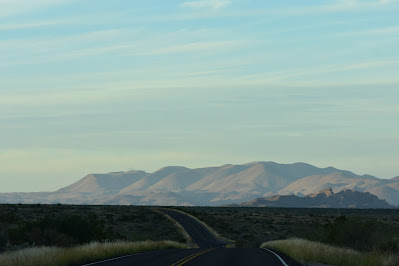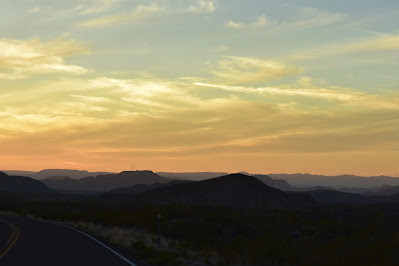Monday, November 7, 2022
(Fair warning, we visited Big Bend National Park three times and each time there were lots of pictures taken. Therefore, the next few blogs will have a picture overload.)
Below are pictures of FM-170 between Maverick Ranch RV Park and where we turned off of TX-118. It was seventeen miles and we took this same route the three days we visited the park. There were several hills and turns along with a few straight stretches. The collages below are a combination of all three days and honestly not sure if they are any kind of order.

 |
The sign reads, Passing Wind. Behind the fence is a full
size submarine conning tower and what looks like a replica
of a pirate ship. It is not a tourist stop it just looks like
someone's personal art display. |
 |
| This is where we turned right and headed towards the park. |
Big Bend National Park is an American national park located in West Texas, bordering Mexico. The park has national significance as the largest protected area of Chihuahuan Desert topography and ecology in the United States, and was named after a large bend in the Rio Grande/Río Bravo. The park protects more than 1,200 species of plants, more than 450 species of birds, 56 species of reptiles, and 75 species of mammals. Additional park activities include scenic drives, programs led by Big Bend park rangers, and stargazing.
The area has a rich cultural history, from archeological sites dating back nearly 10,000 years to more recent pioneers, ranchers, and miners. The Chisos Mountains are located in the park, and are the only mountain range in the United States to be fully contained within the boundary of a national park. Geological features in the park include sea fossils and dinosaur bones, as well as volcanic dikes.
The park encompasses an area of 801,163 acres (1,251.8 sq mi), entirely within Brewster County. For more than 1,000 miles the Rio Grande/Río Bravo forms the boundary between Mexico and the United States, and Big Bend National Park administers approximately 118 miles along that boundary.
Because the Rio Grande serves as an international boundary, the park faces unusual constraints while administering and enforcing park rules, regulations, and policies. In accordance with the Treaty of Guadalupe Hidalgo, the park's territory extends only to the center of the deepest river channel as the river flowed in 1848. The rest of the channel and the land south of it lies within Mexican territory. The park is bordered by the protected areas of Cañón de Santa Elena and Maderas del Carmen in Mexico. (information found online)
We have arrived at the park. Our first stop is to show Tom's Golden Pass. We spent $10.00 back in 2014 and it was $10's well spent; since then have been able to go into quiet a few of our National Parks with it. Today that same pass cost $80.00 for seniors and is still well worth the price.
 |
| I took this picture on our second visit. |
The views as we drive through the park towards our first stop which will be the Visitor's Center at Panther Junction.



At this point we stopped at the Panther Junction Visitor Center. We had a couple of questions about the park and the different roads. We also took the time to watch a moving about the park. Plus, we wanted to get a stamp in our National Park Passport booklet. Then we continued towards the Rio Grande Village Visitor Center with our goal being to drive to the Boquillas Canyon Overlook just beyond there.
 |
| There ore ocotillos everywhere we look. |
 |
This picture was taken from the parking lot
at the Rio Grande Village Visitor Center.
(Second Passport Stamp) |
The collared peccary (Tayassu tajacu), commonly known as the javelina, is found as far south as Argentina and as far north as Texas, New Mexico, and Arizona. Collared peccaries are in the even-toed, hoofed mammal order of Artiodactyla. Javelina are mistaken for pigs, but they are in a different family than pigs.
Javelina thrive in a variety of habitats and are able to easily adapt to different areas within their territory. Javelina are herbivores (plant eaters) and frugivores (fruit eaters). Succulent prickly pear pads make it possible for javelinas to survive until rainfall provides additional new annual food plants and water sources. Javelinas drink water when it can be found, but it is not essential if succulents are available.
On average, javelina live 7 years in the wild. Javelina live in groups (or bands), but do not form long-term pair bonds. Band size ranges from five to twenty-seven animals, with an average of fourteen per band in Big Bend National Park. Since the 1940's, javelina have been considered a sporting game animal in Texas, providing income for landowners and the State of Texas by way of hunter's fees. Within Big Bend National Park, javelina are protected. (information obtained online)
 |
| Javalinas walking through the Rio Grande Village RV. |
 |
| The road to a |
 |
| Picnic Area past the Rio Grande Village RV Park. |
 |
| Boquillas Crossing. The sign said, closed. |
 |
| Standing in the lookout area. |
 |
There were hundreds of "trinkets" for sale. Some as much as
$60. There was no one there and only this metal pipe thing with
a slot to put the money in. There was a sign asking you to
help the owner and the sign was weather worn though not the
merchandise. I must say it was interesting to see this there. |
 |
One last look at the Rio Grande River and we headed
down a road to a trailhead. |
 |
| Then we headed back towards the entrance to the park. |
 |
| This stop was just before going back through the tunnel. |
 |
| The sun is setting behind the Chisos Mountains |
 |
| and the grass along the road |
 |
| glows in the light. |
 |
We saw the sun slip behind the mountains several times
as we drove. |
 |
The sun is gone but the afterglow lingers as we continue
our drive out of Big Bend National Park. |
It was a wonderful ride and as we headed home we talked about our next visit and what ride we would like to take. We stopped for dinner at the High Sierra Bar & Grill. The food was decent the atmosphere, no comment, but the staff was friendly and did stop several times to make sure we were doing okay. I will say this I was very disappointed in the Margarita I had. I realized with the first sip they did not make them fresh and it was actually a "wine" one. Live and learn, should have looked at the menu before ordering the drink. In the end it was not a terrible experience just not sure we would stop there again. After dinner we headed home. It was a good day!
We are glad you stopped by!
If you have time to leave a comment we would enjoy hearing from you.
































































Thanks for the memories of the many months I have been there over the last fifty years. The other four big parks near there are really nice and fun also. I was actually there the year before Terlingua Ranch Estates began.
ReplyDeleteIt makes me smile to know that today's blog would bring back memories for someone else. Thank you for sharing. I can see why you spent so much time there. Way to much to see in just one visit.
DeleteVery pretty country. Those park passes are definitely worth it. Got mine when they were free. They figured out rather quickly they could charge for them, but still worth it!!
ReplyDeleteIt is a beautiful country. This area is just one of the many we have been lucky enough to visit. Free!!!! and we thought $10 was a good deal...lol
DeleteThank you for all those photos. It is a lovely park and for sure worth to go back several times also because of its grand size. I'd like to visit it too.
ReplyDeleteYou are welcome! It is a beautiful park and I think it will stay on our bucket list for a revisit.
DeleteMy, that park looks alot like Arizona. I have just got to go there one winter. Beautiful mountains and the park is huge. Thanks for taking me along. Not so far there as Arizona for me.
ReplyDeleteThe park is in the Chihuahuan Desert which is why I think it reminds you of Arizona. It is a huge park and I am pretty sure you would enjoy some of the hikes available.
DeleteThe views speak to a person. Thanks for sharing.
ReplyDeleteDeb
You are welcome!
Delete